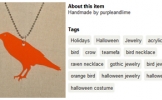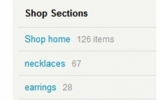Posted by Jennifer Rapp Peterson
Etsy's growth and changes to its marketplace has sellers questioning whether or not Etsy is worth the ongoing investment. Is what's good for Etsy, good for you too?
The Golden Years of Selling Art on Etsy
Etsy delivered a business-making marketplace when the site launched in 2005. Never before had thousands of independent artists enjoyed the kind of exposure Etsy provided. As a consumer of handmade items, I had discovered handmade heaven. Etsy had me at hello.
Many of my artist friends found Etsy to be the easiest, most affordable way to start selling online. All of them had a healthy customer base through a variety of direct sales channels. So, when we launched IndieMade's website platform in 2009, I erroneously assumed most sellers were like my friends and used Etsy primarily for the shopping cart — a simple way for folks to purchase their wares online.
What was I thinking? I had completely overlooked Etsy's value as a marketing and sales channel.
Shoppers looking to buy handmade work knew they could come to Etsy to find what they wanted. Once on Etsy, buyers could use the site's easy built-in search to find the products they were looking for, and site wide promotional tools such as treasuries and forums drove even more traffic to individual shops. There were plenty who started an Etsy shop and instantly had a market for their work – no marketing dollars spent. Suddenly, a growing number of artists were making a living selling on Etsy exclusively.
Etsy is Big Business
But things have changed. Although the exposed air ducts at Etsy headquarters don handknit vent cozies, Etsy is a massive marketplace. According to Etsy.com, the site has 25 million users and receives a whopping 1.5 billion page views each month. Today, it isn't quite as easy to put up a shingle on Etsy and expect to sell items from the start.

Realistically speaking, there are 60 thumbnail positions on the first page of any search results page on Etsy, out of 18,000,000 active listings. Granted, searchers can drill down to very specific types of products, but how much are visitors drilling down into the 850,000+ active customer sites?
As Etsy grows in size, the odds of sellers' items showing up in search decrease overall. There is only so much screen space, no matter how savvy the search engine or how slick a seller's SEO. Etsy's growth is an increasing burden on sellers, who today work harder than ever to get found on the site.
Powerful Curators
Even with the introduction of personalized search, getting exposure on category and subcategory pages relies heavily on Etsy's curators. The recently added Browse feature is a prime example. According to Etsy:
"...each top-level browse page has its own landing page, featuring a selection of images and links. The items featured in the images are hand-picked by Etsy Admin in an effort to best represent the theme of their section. These images, as well as the sections they represent, will rotate periodically to stay seasonally relevant and fresh. At this time, we don’t have a timeline that we can share regarding how often these will change."
Unhealthy Competition
As with any market, there's competition. The larger the market, the more competitive it becomes, and products are commoditized. For an artist, competing on price is a losing proposition for everyone involved. It destroys the handmade spirit, marginalizes an artist's work, and depersonalizes the maker-customer relationship. Check out Jessika Hepburn's article on the Handmade Economy.
Overburdened Etsy Police
And as sites are added, the marketplace becomes increasingly difficult to police. Shop owners can only sell handmade, vintage, and supplies on Etsy, but shops filled with cheap mass-produced goods frequently turn up on the site. Etsy shuts down these rule-breaking shops - but the site's watchdogs can't be everywhere at once on such a large and busy marketplace. Violating stores – who charge factory prices – also make it even more difficult for handmade sellers to make money.
What's Good for Etsy
Although Etsy exudes a communal vibe and waves the flag of social responsibility, Etsy is very much a for-profit business, like any other business. Etsy has every right to make changes to its business and services to make more money, but those changes can have huge impacts on individual sellers, for better or for worse. Sellers can't control how or when Etsy chooses to make changes to the site; all sellers can do is roll with the changes and try to figure out how to tweak their shops so that they're still being found.
We all witnessed Etsy's power by the very public outrage from sellers whose shops were closed due to Etsy's sometimes wrongful enforcement of their handmade criteria, as well as those who watched their views and sales nosedive overnight when Etsy switched to relevancy search. Some sellers saw a steady income vanish before their eyes.
As artists, we owe a lot to Etsy. Etsy is responsible for fueling the handmade movement and creating an economy around handmade. But, we shouldn't be surprised if they don't consider what's best for any single seller when making their next corporate decision.
It begs the question: is Etsy worth the investment? It's a question only you can answer. I would love to know your thoughts!




